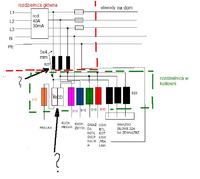Hello
I had a power box in the boiler room, which I expanded because an electrician once made only two sockets for me in the kitchen. I didn`t pay attention to it before plastering and painting.
The boiler room is located behind the kitchen wall.
Later, I added a laundry room next to the boiler room, and electricity had to be supplied from somewhere without having to break down the walls.
I did it as in the diagram. now I have doubts.
Can I put the differential there (not yet installed) on the washing machine? can there be two on one circuit, what about selectivity?
Can I throw away these B25 protections from the RG?
Or maybe connect the differential switch before the main one and install another one in the switchboard in the boiler room and an additional one for the washing machine? in this option, higher costs by another differential, which I would prefer to avoid.

I had a power box in the boiler room, which I expanded because an electrician once made only two sockets for me in the kitchen. I didn`t pay attention to it before plastering and painting.
The boiler room is located behind the kitchen wall.
Later, I added a laundry room next to the boiler room, and electricity had to be supplied from somewhere without having to break down the walls.
I did it as in the diagram. now I have doubts.
Can I put the differential there (not yet installed) on the washing machine? can there be two on one circuit, what about selectivity?
Can I throw away these B25 protections from the RG?
Or maybe connect the differential switch before the main one and install another one in the switchboard in the boiler room and an additional one for the washing machine? in this option, higher costs by another differential, which I would prefer to avoid.



